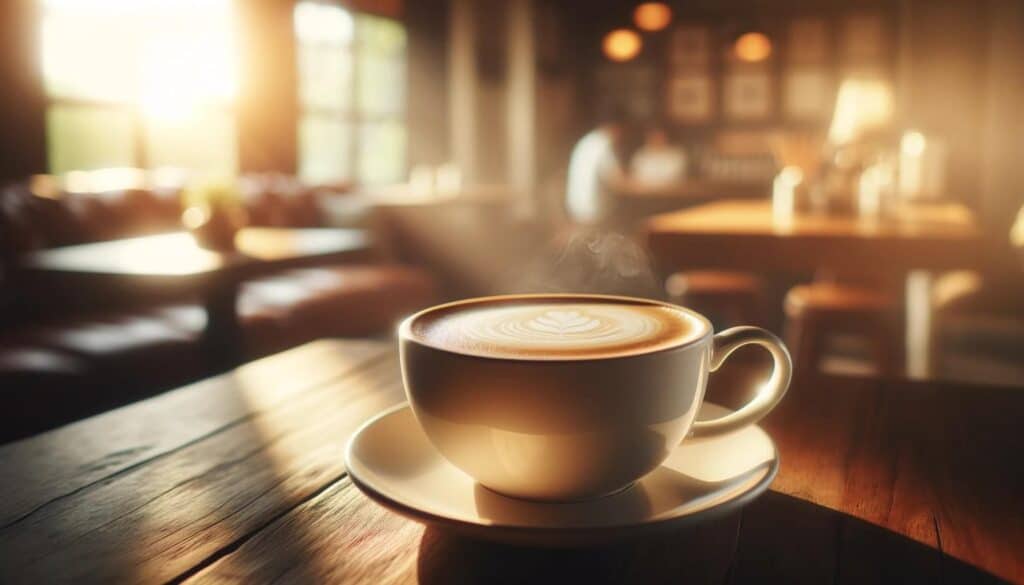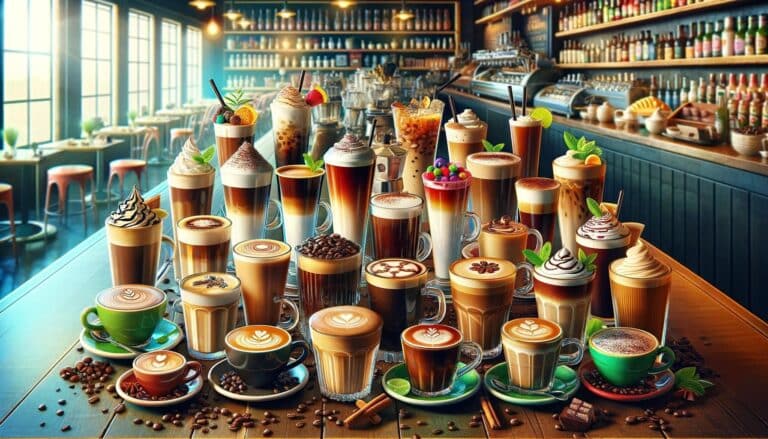People around the world love Café au Lait, a simple yet fancy coffee drink. It mixes the strong taste of coffee with creamy milk. To make a Café au Lait, you blend equal parts of hot, fresh coffee and warm milk. This mix creates a smooth and comforting drink, perfect for a relaxed morning. It’s less intense than espresso-based drinks.
Café au Lait started in Europe, mainly in France, and has a long history linked to the growth of coffee culture. Its name means “coffee with milk” in French and has become more than just a drink. It’s a part of daily life in many cultures. In France, people often have it for breakfast in big bowls, along with bread or pastries. In places like New Orleans, Café au Lait has its own local twist, adding chicory for a unique flavor. This drink shows us different food tastes in various regions and the social side of drinking coffee, from busy Paris cafes to cozy kitchens at home.
What is a Café au Lait?
A Café au Lait is a popular coffee drink that combines equal parts of steamed milk and freshly brewed coffee. The term is French for “coffee with milk.” It is similar to a latte, but typically has a stronger coffee flavor because it uses brewed coffee rather than espresso. Café au Lait is often enjoyed with breakfast in France and in other parts of the world. It’s a simple, yet delicious beverage that’s easy to make and can be enjoyed at any time of the day.
Understanding Café au Lait

Definition and Key Characteristics
Café au Lait is a coffee beverage that typically consists of equal parts of strong, hot coffee and steamed milk. It is known for its rich, creamy texture and balanced flavor that merges the robustness of coffee with the smoothness of milk. Key characteristics include:
- Ratio: The classic 1:1 ratio of coffee to milk is essential for achieving the perfect balance of flavors.
- Coffee Type: Generally, a strong brewed coffee, often a dark roast, is used rather than espresso.
- Milk: The milk is usually steamed but not frothed to a great extent, which results in a creamy consistency without the significant foam found in other coffee drinks.
- Serving Style: Traditionally served in a large cup or bowl to accommodate its volume and for easy dipping of pastries.
- Flavor Profile: It offers a milder coffee experience, with the milk softening the coffee’s bitterness, making it a favored choice for those who prefer a less intense coffee taste.
Comparison with Similar Beverages
- Latte:
- Coffee Base: A latte uses espresso instead of regular coffee.
- Milk Ratio: Lattes have more milk and less coffee, typically in a 3:1 ratio of milk to espresso.
- Milk Texture: The milk in lattes is steamed and frothed more, resulting in a thicker layer of foam on top.
- Flavor: Tends to be milkier and creamier due to the higher milk content.
- Cappuccino:
- Coffee Base: Like a latte, a cappuccino is made with espresso.
- Milk Ratio: The ratio in a cappuccino is around 1:1:1 for espresso, steamed milk, and milk foam, creating distinct layers.
- Milk Texture: Cappuccino has a significant amount of frothed milk, leading to a frothy and airy texture.
- Flavor: Offers a stronger coffee flavor compared to a Café au Lait, with the froth adding a light and airy feel.
In summary, while Café au Lait, lattes, and cappuccinos all blend coffee and milk, the differences lie in the type of coffee used, the milk-to-coffee ratio, the texture of the milk, and the overall flavor profile. Café au Lait is distinguished by its use of brewed coffee, equal balance of milk and coffee, and its smooth, comforting taste.
Historical Background

Origins of Café au Lait
The origins of Café au Lait can be traced back to European coffee houses in the 17th century, particularly in France. It emerged during a time when coffee was becoming a popular commodity in Europe, thanks to trade routes with Africa and the Middle East. The French, known for their love of culinary arts, began experimenting with coffee by adding hot milk, which led to the birth of Café au Lait. This was a departure from the traditional way of drinking coffee – strong and black – prevalent in other parts of Europe.
Evolution and Regional Variations
- French Café au Lait:
- In France, Café au Lait has remained a staple part of breakfast culture. Traditionally, it is served in a large bowl or a wide-brimmed cup, which is perfect for dipping croissants or baguettes.
- Over time, the French Café au Lait has retained its simplicity, focusing on the quality of the coffee and the proportion of milk to coffee.
- New Orleans Café au Lait:
- The New Orleans version of Café au Lait is distinct, infused with a piece of the city’s history and culture. It is most famously associated with Café du Monde, a landmark coffee shop in the French Quarter.
- The key differentiator is the addition of chicory to the coffee. Chicory, a root that when roasted and ground, extends or substitutes coffee, was used during economic hardships, like the Civil War and the Great Depression.
- Chicory imparts a slightly woody, nutty flavor to the coffee, making the New Orleans Café au Lait a unique variation. It is commonly served with beignets, a type of French doughnut, popular in the city.
Both versions reflect the adaptability and regional influence on Café au Lait. While the French version highlights the classic European approach to coffee, the New Orleans adaptation showcases how local ingredients and historical contexts can give a traditional beverage a unique twist.
Ingredients and Preparation

Basic Ingredients: Coffee and Milk
- Coffee: A strong, dark roast coffee is preferred for its robust flavor. The coffee should be freshly brewed to ensure the best taste.
- Milk: The milk should be fresh and can vary in fat content according to preference. It’s usually heated and lightly steamed.
Step-by-Step Preparation Guide
- Brew the Coffee: Start by brewing a pot of strong coffee. A French press or a drip coffee maker works well for this.
- Heat the Milk: While the coffee is brewing, heat the milk. Avoid boiling; just heat until it’s warm and starts to steam. For a more authentic experience, steam the milk to create a little froth but not as much as a latte or cappuccino.
- Combine Coffee and Milk: In a large cup or bowl, pour equal parts of the hot coffee and the heated milk. The classic Café au Lait ratio is 1:1.
- Serve Immediately: Enjoy your Café au Lait immediately while it’s warm.
Variations in Milk
- Whole Milk: Provides a rich and creamy texture, enhancing the overall body of the drink.
- Skim Milk: A lighter option that reduces the creaminess but still offers a smooth taste.
- Plant-Based Milks: For those who are lactose intolerant or prefer plant-based diets, alternatives like soy, almond, or oat milk can be used. These milks change the flavor profile slightly and can alter the texture, with some providing creaminess similar to whole milk.
When using plant-based milks, it’s important to choose ones that heat well without curdling. Barista versions of these milks are often specially formulated to perform better with hot drinks. The choice of milk can transform the Café au Lait experience, catering to different dietary needs and flavor preferences.
Tasting and Serving

Ideal Flavor Profile
A well-prepared Café au Lait should strike a perfect balance between the robustness of coffee and the creaminess of milk. The ideal flavor profile includes:
- Smoothness: The milk softens the harsher notes of the coffee, resulting in a smooth and velvety texture.
- Mild Coffee Flavor: The strength of the coffee should be noticeable but not overpowering, offering a milder and more approachable taste than black coffee.
- Slight Sweetness: While not inherently sweet, the milk’s natural sugars should lend a subtle sweetness to the drink.
- Warmth: The beverage should be served warm, enhancing its comforting and soothing qualities.
Traditional and Modern Serving Methods
- Traditional Serving:
- In France, it’s traditionally served in a large bowl or a wide-brimmed cup, allowing for easy dipping of pastries.
- Often enjoyed as a leisurely morning drink, it’s not uncommon to find people lingering over their Café au Lait and breakfast.
- Modern Serving:
- In contemporary settings, Café au Lait is often served in standard coffee cups or tall glasses, adapting to the on-the-go lifestyle.
- Special presentation styles, like latte art, have also become popular in some modern cafes, adding an artistic touch to the drink.
Pairing with Foods
Café au Lait is incredibly versatile when it comes to food pairings. Some popular options include:
- Pastries: Croissants, pain au chocolat, or Danish pastries are classic pairings, especially in a traditional French setting.
- Breads: A fresh baguette or artisanal breads can be a delightful accompaniment.
- Breakfast Foods: It pairs well with a variety of breakfast dishes, from eggs and bacon to oatmeal and fruit.
- Desserts: Café au Lait can complement desserts like tiramisu, chocolate cake, or fruit tarts, balancing the sweetness of the dessert with its mild coffee flavor.
- Savory Snacks: For those who prefer savory over sweet, it can also pair well with quiches or savory scones.
The key to pairing is balancing flavors and considering the time of day. Morning pairings tend to be lighter, while afternoon or evening pairings might lean towards more substantial or sweet options.
Café au Lait Around the World

Regional Twists and Unique Practices
- France:
- The epitome of French morning tradition, typically served in bowls or large cups, and often enjoyed with a croissant or baguette for breakfast.
- New Orleans, USA:
- Known for adding chicory to the coffee, giving it a distinctive, slightly bitter, and nutty flavor. Served with beignets, it’s a staple in the local coffee culture.
- Italy:
- Known as “caffè latte,” it’s typically served in a glass and consumed as a breakfast drink. Italian caffè latte is often stronger in coffee flavor compared to its French counterpart.
- Spain:
- Similar to the French style but often served with a pinch of cinnamon or a small biscuit, known as “café con leche.”
- Portugal:
- Referred to as “galão,” this version is lighter, served in a tall glass, and typically enjoyed in the afternoon with a pastry.
- Scandinavia:
- Known for their love of coffee, the Scandinavian version might include a lighter roast coffee, focusing on the quality and origin of the beans.
Popular Café au Lait Spots Globally
- Café de Flore, Paris:
- A historic and iconic café known for its classic Parisian Café au Lait and rich history of hosting intellectuals and artists.
- Café du Monde, New Orleans:
- Famous for its chicory-infused Café au Lait and beignets, it’s a must-visit for both locals and tourists.
- Sant’Eustachio Il Caffè, Rome:
- Known for its traditional Italian caffè latte, prepared with meticulously sourced beans and served in a historic setting.
- La Mallorquina, Madrid:
- A popular café in the heart of Madrid, offering a delightful Spanish café con leche experience.
- Fábrica Coffee Roasters, Lisbon:
- A modern café known for its quality beans and contemporary take on the Portuguese galão.
- Fika Coffee Shops, Stockholm:
- Representing the Swedish coffee break tradition “fika,” these cafes offer a unique Scandinavian coffee experience.
These regional variations and popular spots highlight the global love and adaptation of Café au Lait, showcasing how a simple combination of coffee and milk can be interpreted and enjoyed in diverse ways across different cultures.
Making Café au Lait at Home

Equipment Needed
- Coffee Maker: A French press, drip coffee maker, or any preferred method to brew strong coffee.
- Milk Steamer/Frother: For heating and lightly frothing the milk. If unavailable, a small pot and a whisk can work.
- Microwave/Oven (Alternative for Heating Milk): If a steamer is not available, milk can be heated in a microwave or on the stove.
- Large Cup or Bowl: Traditional Café au Lait is served in a large bowl or cup to accommodate the equal parts coffee and milk.
- Measuring Tools: To ensure the correct coffee-to-milk ratio.
Tips for Brewing the Perfect Cup
- Quality Coffee Beans: Start with high-quality, fresh coffee beans, preferably a dark roast for an authentic flavor.
- Correct Ratios: Maintain a 1:1 ratio of coffee to milk for the classic Café au Lait balance.
- Water Temperature: Use water just off the boil (about 195°F to 205°F) for brewing the coffee to extract the full flavor.
- Fresh Milk: Use fresh milk for the best taste and texture. Heat the milk until warm but not boiling.
- Gentle Frothing: If you prefer a bit of froth, froth the milk gently. Traditional Café au Lait has minimal to no foam.
DIY Variations and Flavors
- Spice It Up: Add a dash of cinnamon, nutmeg, or cocoa powder for a flavorful twist.
- Sweeteners: Incorporate sweeteners like sugar, honey, or maple syrup according to taste.
- Flavored Syrups: Vanilla, caramel, or hazelnut syrups can add a unique and delightful flavor.
- Different Milks: Experiment with different types of milk, like almond, soy, or oat milk, for a different flavor and texture profile.
- Iced Café au Lait: For a refreshing variation, let the coffee cool, mix it with cold milk, and serve it over ice.
- Chicory Addition: Like the New Orleans style, add chicory to your coffee grounds for a different flavor profile.
Making Café au Lait at home allows for customization according to personal preferences, making it a versatile and enjoyable experience. Whether sticking to the traditional method or experimenting with new flavors, the key is to find the perfect balance that suits your taste.
Health and Nutrition
Nutritional Overview
The nutritional content of a Café au Lait can vary based on the type of milk and the amount of added sweeteners. A standard serving made with equal parts of brewed coffee and whole milk, without added sugar, typically contains:
- Calories: Ranges from 40 to 120 calories per 8-ounce serving, mainly depending on the type of milk used.
- Protein: About 4-8 grams, contributed by the milk.
- Carbohydrates: Approximately 5-12 grams, from the lactose in milk.
- Fat: Varied fat content (0-8 grams) based on the choice of milk (skim, 2%, whole).
- Caffeine: Around 95 mg of caffeine per 8 ounces of brewed coffee.
Benefits
- Energy Boost: The caffeine in coffee helps improve alertness and concentration.
- Antioxidants: Coffee is rich in antioxidants which help in reducing oxidative stress in the body.
- Bone Health: Milk is a good source of calcium and vitamin D, essential for bone health.
- Mental Health: Moderate coffee consumption has been linked to a reduced risk of depression and cognitive decline.
Potential Drawbacks
- Caffeine Sensitivity: Overconsumption of caffeine can lead to restlessness, anxiety, heart palpitations, and may disrupt sleep patterns.
- Caloric Intake: When made with whole milk or added sweeteners, the calorie count can increase, which might be a concern for those monitoring caloric intake.
- Lactose Intolerance: Individuals who are lactose intolerant may experience digestive discomfort if consuming Café au Lait made with regular dairy milk.
- Acidity: Regular consumption of coffee can increase stomach acidity, potentially leading to digestive discomfort for some people.
While Café au Lait can be a nutritious and enjoyable part of a balanced diet, it’s important to consider the type of milk and the amount of added sugar. As with any food or beverage, moderation and awareness of one’s own dietary needs and reactions are key.
Café au Lait in Popular Culture
References in Film, Literature, and Media
- Film: Café au Lait often features in French and European cinema, symbolizing leisure and sophistication. It has been showcased in various scenes depicting morning routines or intimate conversations in cafes.
- Literature: Many authors have used the imagery of Café au Lait to set scenes in cafes, depicting the beverage as a part of daily life, especially in stories set in France or New Orleans.
- Television and Media: Lifestyle and travel shows frequently highlight Café au Lait when exploring French or New Orleans culture, focusing on its traditional preparation and local significance.
- Advertising: Coffee brands often use Café au Lait in marketing to evoke a sense of comfort and simplicity, appealing to those who enjoy a milder coffee experience.
Its Role in Coffee Culture and Trends
- Symbol of Relaxation: Unlike espresso-based drinks often associated with a quick caffeine fix, Café au Lait is typically portrayed as a beverage for leisurely enjoyment, reflecting a slower, more relaxed lifestyle.
- Home Brewing Trend: With the rise of home brewing, more people are experimenting with making Café au Lait at home, contributing to its popularity and versatility.
- Coffee Shop Menus: Many coffee shops around the world offer Café au Lait, catering to customers who prefer a less intense coffee flavor. It’s often a staple on menus alongside more modern coffee creations.
- Cultural Events: In areas like New Orleans, Café au Lait is an integral part of local festivals and cultural events, showcasing its significance in regional traditions.
- Social Media Influence: Influencers and coffee enthusiasts often share their Café au Lait experiences on social media platforms, highlighting its aesthetic appeal and the comforting ritual of its preparation and consumption.
The presence of Café au Lait in popular culture and modern coffee trends underscores its enduring appeal. It’s not just a beverage but a cultural icon that represents a blend of tradition, comfort, and the simple pleasure of enjoying a good cup of coffee.
Conclusion
Exploring the world of Café au Lait shows us much more than how coffee and milk mix. It opens up a rich story of cultural history, regional styles, and love from all over the world. This classic drink started in European coffee houses and has become a symbol of relaxation, comfort, and simple cooking.
Café au Lait’s charm comes from its perfect mix: strong coffee made milder with creamy milk. This creates a drink that wakes you up and calms you down at the same time. People enjoy it in different ways – in a traditional French café, with beignets in New Orleans, or made at home. Café au Lait goes beyond places and cultures.
What makes Café au Lait special is how you can make it in different ways and it suits all kinds of tastes. Some people like it with rich whole milk, while others prefer plant-based options. Its role in popular culture and media also shows it’s a mainstay in the coffee world.
To sum up, Café au Lait is more than a morning drink or a regular coffee shop order. It’s a delightful experience that fits right between quick espresso shots and slow-paced tea times. For anyone wanting to expand their coffee knowledge, getting into Café au Lait not only lets you enjoy its creamy taste but also learn about history and culture. Whether you’re a big coffee fan or just drink it now and then, exploring Café au Lait’s different sides will definitely add to your coffee adventure.
References and Further Reading
- NESCAFÉ. (n.d.). What is Café au Lait? NESCAFÉ India. https://www.nescafe.com/in/coffee-types/what-is-a-cafe-au-lait
- Prince, M. (2022, September 25). How to Make a Cafe au Lait. CoffeeGeek. https://www.coffeegeek.com/guides/cafeaulait/
- Kasperowicz, M. (2020, February 6). Café Au Lait: A French Classic. Trade Coffee. https://www.drinktrade.com/blogs/education/how-is-cafe-au-lait-different-from-a-cafe-latte






